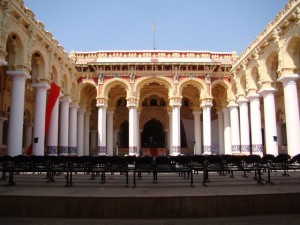Thirumalai Nayak Palace is a 17th century palace erected in 1636 AD by King Thirumalai Nayak, a king of Madurai’s Nayaka dynasty who ruled Madurai from 1623-59, in the city of Madurai, India. This Palace was built with the help of an Italian designer and is a classic synthesis of Dravidian, Islamic and European styles. The building, which can be seen today, was the main Palace where the king lived. The original Palace multifaceted was four times bigger than the present structure. In its prime, Tirumalai Nayak Palace at Madurai was considered to be one of the wonders of the South. This palace is situated 2 km south east of the Meenakshi Amman Temple.
History
The Nayaks of Madurai ruled this former Kingdom from 1545 till 1740’s and Thirumalai Nayak (1623-1659) was one of their greatest kings that line noteworthy for a variety of buildings in and around Madurai. During the 17th centuries the Madurai Kingdom had Portuguese, Dutch and other Europeans as traders, missionaries and visiting travellers. Tirumala Nayak is believed to have recruited the services of an Italian architect, for the construction of his Palace. Over a span of 400 years many parts of the buildings were suffered much by time, and not inconsiderably… by the unhelpful effects of war; a few, however, are sufficiently in repair to be converted into use by the garrison, as granaries, store-houses, powder magazines during time of East India Company.
Built in 1636, as a central point of his capital at Madurai, Thirumalai Nayak planned the palace to be one of the grandest in South India. The design and architecture is a blend of Dravidian, Islamic and European styles. It is the Interior of the Palace that surpasses many of its Indian generation in style and details while the exterior is minimalistic by comparison.
During the 18th century many structures that were part of this palace were pulled down or included into buildings in the neighbouring streets. What remains is the enclosed court known as the Svarga Vilasam and a few adjoining buildings. The audience chamber of the Svarga Vilasam is a vast hall with arcades about 12 m high. The architecture is a blend of indigenous and Islamic forms.
Thirumalai Nayak Palace is a feast to the eyes in the evening. The Indian cultural section conducts the famous Sound and Light Show at the palace premises daily. The huge entrance of the Palace opens into the vast enormous courtyard spreading over an area of 3700sq.m. Presently a garden is located in this patio and it also holds huge pillars circular in shape. The palace was built with foliated masonry and the mixture of shell lime known as Chunnam and with egg white was used to obtain the classy surface finish.
The major parts that are within the palace premises include the royal residence, , shrine, apartments, armory, theatre, palanquin place, quarters, royal bandstand, garden and a pond. These parts are originally divided into two major parts namely Ranga Vilasam and Swarga Vilasam. Wonderful art works and ceilings are the major reasons for the stylishness of this edifice.
The show, an amazing spectacle of sound and light, narrate in a subtle and attractive way the lifetimes of King Thirumalai. Myriad hues of light plays truant with the palace walls transforming the dark patio and surrounding area into a real vista of the Thirumalai Nayak’s Madurai. The show is an ode to King Thirumalai and his glory. It presents anecdote from his life his victory, his enemies, his daily routine, his passion for arts and his vision for the city in theatrical and regal splendor. The palace turns into a symphony of sound and light at night time, with every pillar becoming an eloquent story teller and every cornerstone narrating the glory of the past.
The Sound and Light show takes place every day from 6.30 PM (IST). The English show happens at 6.30 PM while the Tamil (local language) show is scheduled at 8 PM. The duration of each show is half an hour.




